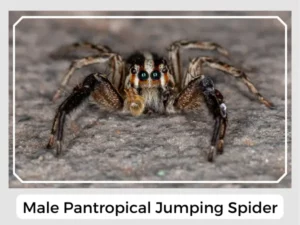The Plexippus paykulli, commonly known as the Pantropical jumping spider, is a fascinating species of spider that has captured the interest of both scientists and enthusiasts alike. This spider is known for its remarkable agility and has a widespread presence across tropical and subtropical regions around the globe. Its ability to adapt to various environments and its distinctive physical characteristics make it a subject of interest for study and observation.
The eggs of Plexippus paykulli are laid in secure, silk-woven sacs. The mother spider guards these sacs zealously, ensuring the safety of her future offspring.
Upon hatching, spiderlings are highly independent. They soon venture out to fend for themselves, using their innate jumping ability to escape predators and catch prey.
Unlike many other spiders, pantropical jumping spider does not rely on webs to catch prey. Instead, they use silk to create shelters or retreats and to secure egg sacs. Their hunting strategy involves active pursuit and jumping to ambush their prey.
Yes, these spiders are venomous, like most spiders, but their venom is not harmful to humans. The venom is designed primarily to immobilize their prey, which consists of smaller insects.
While Plexippus paykulli can bite, they are generally not aggressive towards humans and bites are very rare. If threatened or provoked, they may bite in self-defense. However, their bite is not considered dangerous to humans and typically results in no more than minor redness or swelling.
Natural Predator: Pantropical jumping spiders play a crucial role in controlling insect populations, acting as natural predators to a variety of pests.
Prey-Predator Dynamics: These spiders contribute to maintaining the ecological balance by regulating the populations of their prey, thereby preventing overpopulation and the potential harm it could cause to crops and natural vegetation.
Relationship with Humans: Generally, Pantropical jumping spiders are beneficial to humans by reducing the population of pests. Their presence in agricultural fields and gardens can be advantageous in managing pest control naturally.
| Distribution | Widely distributed in tropical and subtropical regions of Asia and Africa |
| Habitat | Found in warm, tropical, and subtropical habitats worldwide, including gardens and inside buildings. |
| Diet | Predominantly insects and other small arthropods |
| Lifespan | Up to 3 years |
| Predators | Birds, lizards, and larger spiders |
| IUCN Conservation Status | Not Listed |

In conclusion, the Pantropical jumper, with its distinctive jumping ability, plays a vital role in natural pest control, making it an ally in agricultural and garden settings. Its adaptability to various habitats and the fascinating aspects of its behavior and physical characteristics make it a captivating subject for those interested in the natural world.
The Plexippus paykulli, commonly known as the Pantropical jumping spider, is a fascinating species of spider that has captured the interest of both scientists and enthusiasts alike. This spider is known for its remarkable agility and has a widespread presence across tropical and subtropical regions around the globe. Its ability to adapt to various environments and its distinctive physical characteristics make it a subject of interest for study and observation.
The eggs of Plexippus paykulli are laid in secure, silk-woven sacs. The mother spider guards these sacs zealously, ensuring the safety of her future offspring.
Upon hatching, spiderlings are highly independent. They soon venture out to fend for themselves, using their innate jumping ability to escape predators and catch prey.
Unlike many other spiders, pantropical jumping spider does not rely on webs to catch prey. Instead, they use silk to create shelters or retreats and to secure egg sacs. Their hunting strategy involves active pursuit and jumping to ambush their prey.
Yes, these spiders are venomous, like most spiders, but their venom is not harmful to humans. The venom is designed primarily to immobilize their prey, which consists of smaller insects.
While Plexippus paykulli can bite, they are generally not aggressive towards humans and bites are very rare. If threatened or provoked, they may bite in self-defense. However, their bite is not considered dangerous to humans and typically results in no more than minor redness or swelling.
Natural Predator: Pantropical jumping spiders play a crucial role in controlling insect populations, acting as natural predators to a variety of pests.
Prey-Predator Dynamics: These spiders contribute to maintaining the ecological balance by regulating the populations of their prey, thereby preventing overpopulation and the potential harm it could cause to crops and natural vegetation.
Relationship with Humans: Generally, Pantropical jumping spiders are beneficial to humans by reducing the population of pests. Their presence in agricultural fields and gardens can be advantageous in managing pest control naturally.
| Distribution | Widely distributed in tropical and subtropical regions of Asia and Africa |
| Habitat | Found in warm, tropical, and subtropical habitats worldwide, including gardens and inside buildings. |
| Diet | Predominantly insects and other small arthropods |
| Lifespan | Up to 3 years |
| Predators | Birds, lizards, and larger spiders |
| IUCN Conservation Status | Not Listed |

In conclusion, the Pantropical jumper, with its distinctive jumping ability, plays a vital role in natural pest control, making it an ally in agricultural and garden settings. Its adaptability to various habitats and the fascinating aspects of its behavior and physical characteristics make it a captivating subject for those interested in the natural world.